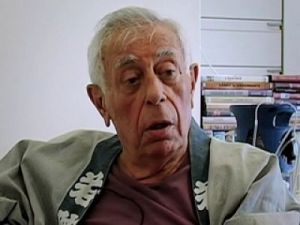STUDIO: Music Box | DIRECTOR: Mitra Farahani
RELEASE DATE: 12/2/2014 | PRICE: DVD $29.95
BONUSES: 1967 short documentary
SPECS: NR | 102 min. | Foreign language documentary| 16:9 widescreen | Dolby Digital 5.1 | Farsi with English and French subtitlesRATINGS (out of 5 dishes): Movie
| Audio
| Video
| Overall
Try naming a contemporary painter whose work has any bearing on the average person living today. There aren’t any—at least, not in American culture. I know nothing about the Iranian art world, but thanks to Mitra Farahani’s Fifi Howls from Happiness, I can tell you this: Bahman Mohassess is a provocative, openly gay painter who flourished in the 1960’s. His work criticized an increasingly repressive government—and an increasingly repressed culture—for years, growing in fame and political turbulence until he could take the censorship no longer. In 1980, he virtually disappeared. Since then, his paintings (and status) have only multiplied in value, deepening the mystery of his departure. Which is why, when Farahani tells us she’s found him living in a hotel somewhere in Rome, you’re eagerly anticipating a fascinating tale…which never comes.
After the enticing introduction that brings us up to the point of Mohassess’ disappearance, Farahani spends most of the film not answering any of the obvious questions his disappearance has raised. Why did he leave? Why did he agree to be interviewed after all this time? What has he been doing with himself in the meantime? You never really get beyond a few hints and anecdotes. Farahani makes it clear this is not the story she’s interested in telling, and instead spends most of the film on Mohassess’ couch, with the great (and now old) artist embellishing his reputation as a cantankerous, opinionated eccentric.
From a filmmaking point of view, there’s not much going on here. A basic camera setup and rudimentary editing push along the most minimal of a storyline: for her film to be great, Farahani must capture the artist in his element, painting. Hence, she must secure him a commission—somewhat of a challenge when dealing with this prickly, high-maintenance master. But she eventually does, via a couple of painters who happen to be huge fans; they’ve clearly got money to burn, and are more than ecstatic about the chance to give their rediscovered idol an opportunity to produce a new masterwork.
That’s the plot, but the heart of the film lies in the relationship between filmmaker and subject. Farahani is young and attractive; Mohassess is old and gay, but he clearly enjoys commanding this beautiful filmmaker’s attention, while she enjoys flaunting a sassy, playful attitude others would be too intimidated to assume. Each plays their role in this quirky relationship, which might have gotten annoying if he weren’t a genuine talent with a topnotch body of work and an interesting point of view. So even though most of our questions go unanswered, we do get to know Mohassess—or, at least, the version he chooses to show us. From a Westerner’s point of view, the man perfectly embodies the mythical painter, married to his art, whose work has had a tangible impact on both individuals and society, ruffling feathers and questioning the mores of his culture. That, alone, makes Fifi Howls From Happiness a worthy and unique documentary, especially with its memorable twist of an ending.
The DVD carries a single, but vital, extra The Eye That Hears, a short 1967 documentary showing a young, brash Mohassess at work while he pontificates on the philosophy of his art. Some of it is curiously prescient, given our 2014 perspective, and it works as a perfect companion to the un-detail-oriented Fifi. There’s still a lot of Mohassess’ story left to be desired, but I guess that’s what the internet is for.
|
Buy or Rent Fifi Howls from Happiness
|
|||
|---|---|---|---|
DVD |
 |
||

Leave a Reply